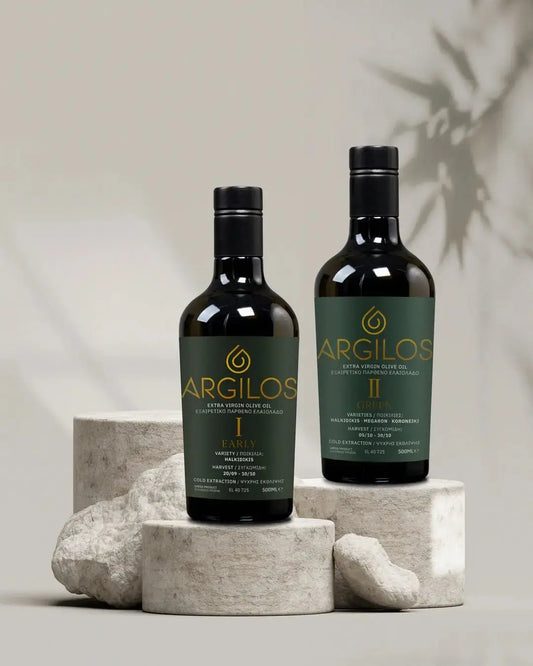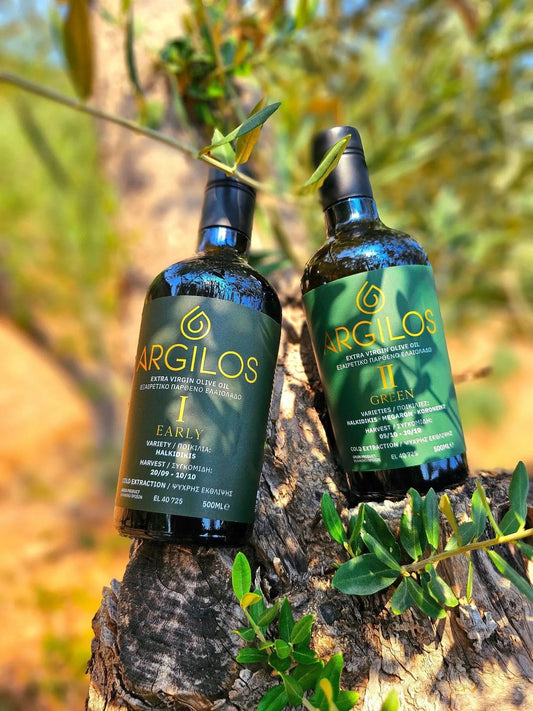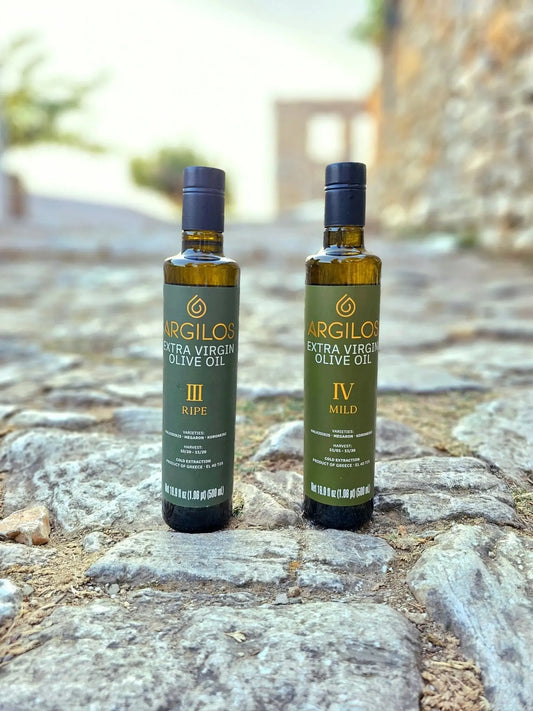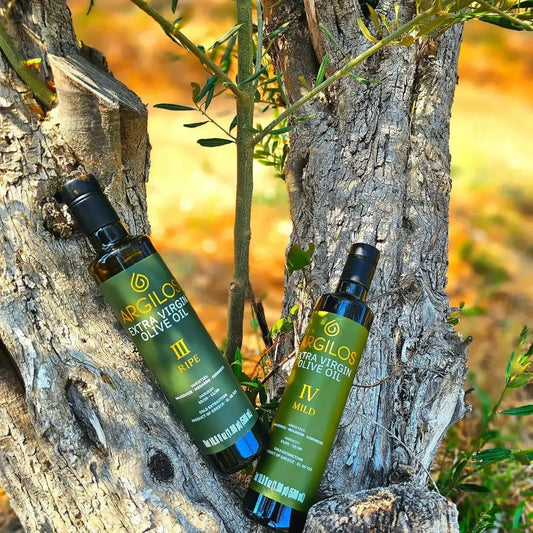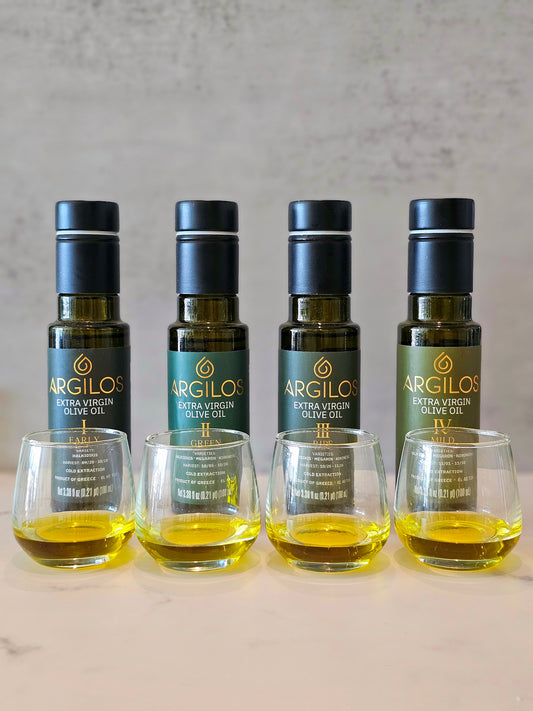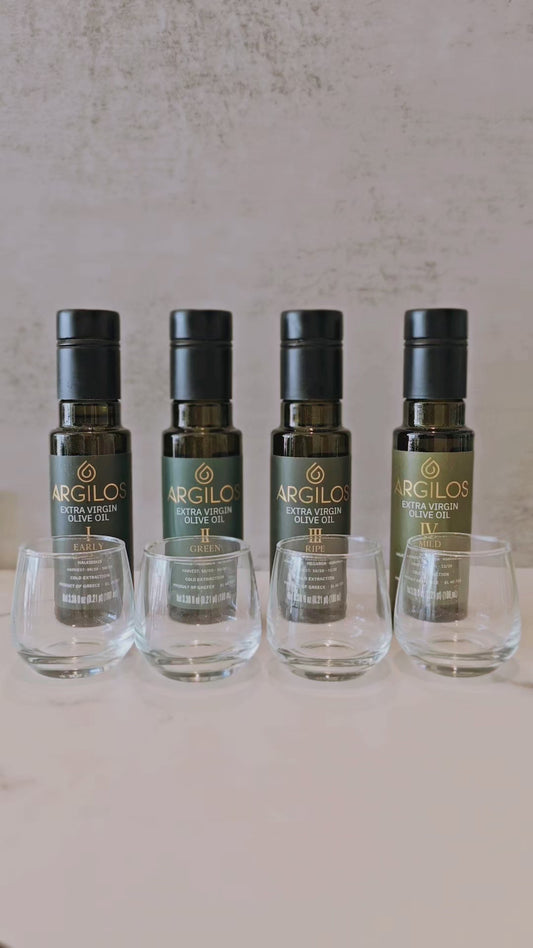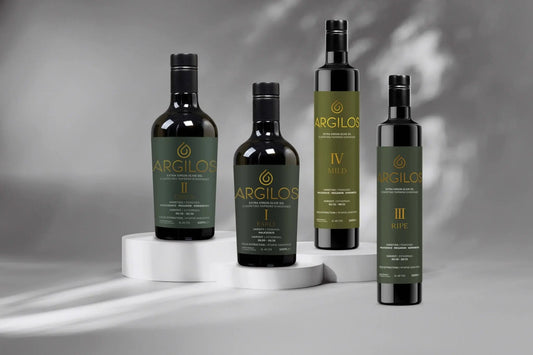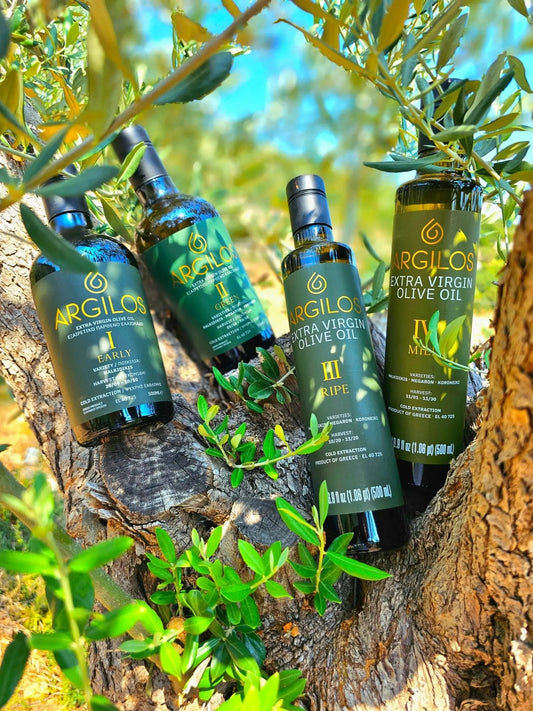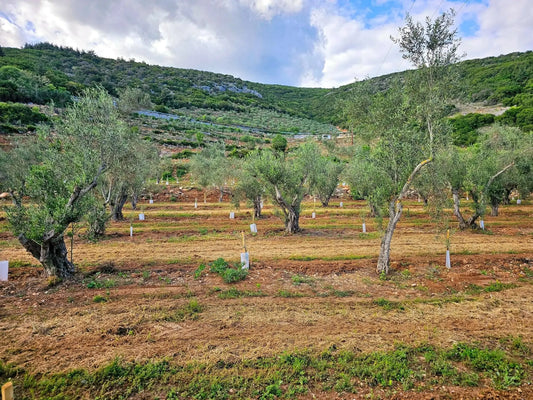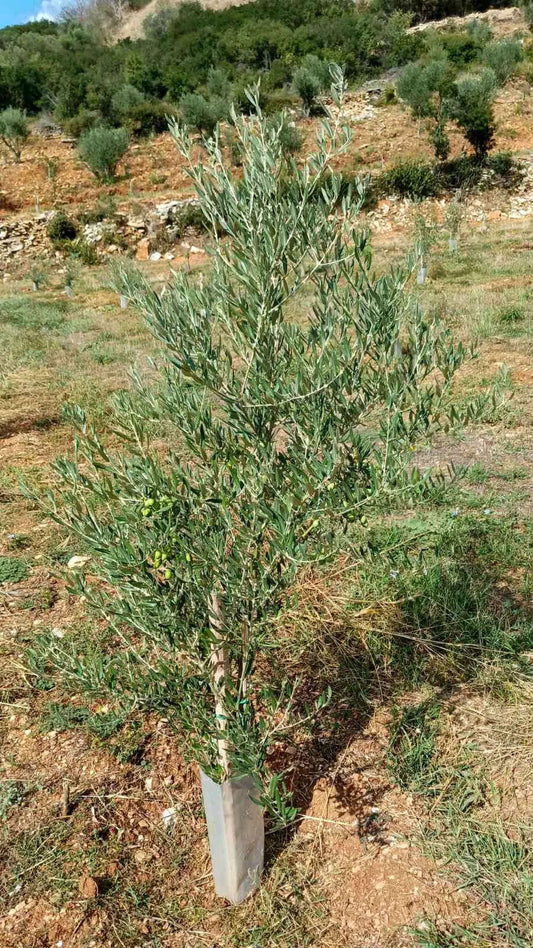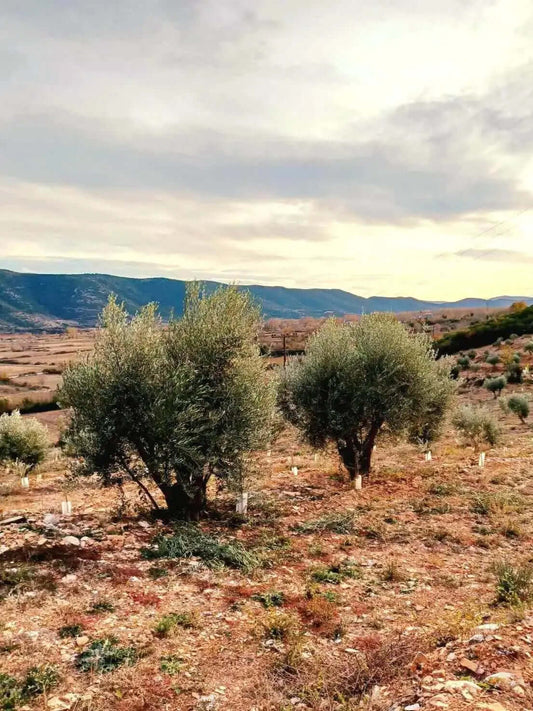Exploration of High-Quality Olive Oils
Share
What Makes a High-Quality Olive Oil?

Not all olive oils are created equal. Quality can vary tremendously, and understanding the differences will help you choose the best oil for your needs. High-quality olive oil is defined by its grade, chemistry, and how it’s crafted from grove to bottle. Let’s break down the key factors:
Not all olive oils are created equal. Quality can vary tremendously, and understanding the differences will help you choose the best oil for your needs. High-quality olive oil is defined by its grade, chemistry, and how it’s crafted from grove to bottle. Let’s break down the key factors:
Grades of Olive Oil
Olive oil comes in several grades, determined by production method and purity. Here are the main ones to know:
Extra Virgin Olive Oil (EVOO) – The Gold Standard: This is the highest grade and what we focus on at Nostos Goods. EVOO is cold-extracted from fresh olives purely by mechanical means (no chemicals or high heat) and must meet strict criteria. It has zero flavor defects (no off tastes like mustiness or rancidity) and naturally low acidity (free fatty acid ≤ 0.8%). In short, extra virgin oil is fresh-squeezed olive juice at its finest, with all the aroma, flavor, and nutrients intact.
Virgin Olive Oil: A step below EVOO, virgin olive oil is also made mechanically but may have slightly higher acidity or minor flavor imperfections. It’s still good, but lacks the exceptional taste and antioxidant levels of EVOO.
Refined Olive Oil: These are lower-grade oils that have been chemically refined to neutralize defects. The result is a bland oil with little aroma or color, often blended with a bit of virgin oil for flavor. Refined oils miss out on the healthful polyphenols and flavors of EVOO.
Olive Pomace Oil: An even lower grade, made by extracting the last bits of oil from olive pulp using solvents. It’s mainly used in commercial frying or soap-making – not something you’d drizzle on a salad.
For the best experience, stick to high-quality extra virgin olive oil for your dressings, dips, and finishing dishes. Lesser grades simply can’t compare to the vibrant taste and benefits of real EVOO.
From Grove to Bottle: Harvest & Extraction
How olive oil is made plays a huge role in its quality. Great olive oil doesn’t happen by accident – it’s the result of careful harvesting and extraction practices that preserve flavor and nutrients.
Harvest Timing: Olives can be harvested early (when green) or late (when ripe). Early-harvest olives yield less oil, but it’s intensely green, robust, and packed with polyphenols (healthy antioxidants). Late-harvest olives (purple/black and fully ripe) give more oil that’s milder, golden, and smoother. Neither is “bad” – it’s a flavor preference – but top producers often offer early harvest oils for those who crave that bold, peppery kick. (At Nostos, for example, our Argilos I (Early Harvest) EVOO is an early pick bursting with grassy, vibrant flavor, whereas Argilos IV (Mild) comes from later olives for a buttery finish.
Harvest Method: The best oils come from olives that are hand-picked or gently harvested. In our groves on Mount Pangaion, we carefully comb the olives from the trees (often with handheld rakes or pneumatic combs) to avoid bruising the fruit. Bruised or ground-fallen olives can start fermenting and lead to off-flavors, so we avoid those. It’s labor-intensive, but it ensures only healthy olives go into our press. (Mechanical harvesters are faster, but can damage olives or trees if not used carefully.)
Speed & Care: Time is flavor! Once picked, olives should be pressed as soon as possible – ideally within hours. We rush our olives from grove to mill the same day, because delays cause olives to oxidize or ferment. Freshly picked + fast pressing = fresher tasting oil. You’ll notice the difference in the aroma and brightness of the oil.
Cold Extraction: High-quality EVOO is extracted cold, meaning the olive paste is kept below about 27°C (80°F) during pressing. Why does this matter? Because heat can destroy delicate flavors and nutrients. There are two main methods to extract oil: the traditional cold-press (literally pressing the paste with mats and presses) and modern cold centrifugation (using a high-speed spinner to separate oil). Both can yield excellent results as long as they’re temperature-controlled. We use modern stainless steel mills that cold-extract the oil, preserving those verdant flavors and heart-healthy compounds.
No Additives or Refining: In EVOO production, nothing is added except maybe a touch of water to help the paste flow. We never use solvents or chemical refining – those are for lower grades. The pure juice of the olive is all you get in the bottle. This is why genuine EVOO has a distinct taste and even a bit of sediment sometimes (tiny olive particles) if unfiltered. It’s a natural product.
Quality checkpoint: when shopping, look for terms like “cold pressed” or “first cold pressed” and a harvest date on the bottle. These signal a producer who values freshness and transparency.
The Chemistry of Quality (Acidity & Polyphenols)
Let’s demystify a couple of the terms you might see on labels or hear about with olive oil quality:
Acidity: This refers to free fatty acid (FFA) level, measured as oleic acid percentage. High-quality extra virgin olive oil has low acidity (≤0.8%). Lower is generally better, indicating sound olives and careful handling. Note that you can’t taste acidity directly, but a low number signals good quality and freshness. (Beware of marketing: some bottles tout “0.3% acidity!” as a brag – it’s good, but many excellent EVOOs range 0.2–0.5%. The key is it should be under 0.8% for EVOO.)
Polyphenols: These are the antioxidant compounds that make olive oil so healthy – and give it that peppery, pungent bite. Polyphenols (like oleocanthal and hydroxytyrosol) fight inflammation and oxidation in our bodies. Oils higher in polyphenols will taste more bitter and peppery (think of the cough or tickle in your throat from a robust oil – that’s a polyphenol called oleocanthal at work!). Fresher oils, early harvest oils, and certain olive varieties naturally have higher polyphenol counts. If you love that strong kick, reach for an early harvest Greek EVOO – they’re often polyphenol powerhouses. If you prefer milder taste, a later harvest or mild variety will have fewer polyphenols but still all the goodness of healthy monounsaturated fats.
Bottom line: High-quality EVOO = low acidity + high polyphenols + great flavor. It’s the complete package of taste and health. In the next sections, we’ll explore how to fully appreciate that flavor and why those polyphenols are so good for you.
How to Taste and Appreciate Olive Oil
Tasting olive oil is a joy in itself – much like tasting wine or coffee. If you’ve never done an olive oil tasting, you’re in for a treat! Here’s how to taste olive oil like an expert and what to look (and sniff and sip) for:
Tasting Like a Pro – Step by Step
You don’t need anything fancy to taste olive oil, just a small cup or even a wine glass, and your senses. Follow these steps to get the full experience:
1. Pour a little oil (about a tablespoon) into a small glass or cup. Cover it with one hand and hold the bowl of the glass in your palms for a minute to gently warm the oil. This helps release the aromas.
2. Swirl the oil in the glass (keep it covered as you swirl). This further releases the aromatic compounds.
3. Sniff: Uncover the glass and immediately inhale deeply. What do you smell? High-quality EVOO can have a bouquet of aromas – freshly cut grass, green apple, tomato leaf, artichoke, ripe olives, even hints of herbs or flowers. Take a moment to enjoy the scent. If it smells musty, waxy (like crayons), or vinegary, that’s a bad sign (possible defect or old oil). A good oil should smell inviting and fresh.
4. Sip and Slurp: Take a small sip and hold it in your mouth. Then slurp in a little air through your teeth, almost like a reverse whistle. (Yes, you might sound funny – that’s okay!) This emulsifies the oil and spreads it across your palate. You’ll taste much more this way. Note the flavors – you might sense fruitiness (olive fruit, perhaps hints of green banana or citrus), bitterness (like leafy greens or walnut skin on the tongue), and pungency (a peppery sensation in your throat). These three – fruitiness, bitterness, pungency – are the holy trinity of olive oil tasting. A well-balanced EVOO will usually exhibit all three in harmony.
5. Swallow (or Spit): If you’re tasting many oils, you might spit like wine tasters do. But if it’s just one or two oils, feel free to swallow and enjoy that lingering peppery warmth in your throat. Professional tasters often describe oils by the intensity of the cough it provokes – a one-cough oil vs. a three-cough oil! A slight cough is a sign of those healthy polyphenols.
6. Cleanse and Compare: If trying multiple oils, cleanse your palate between them. We recommend a slice of green apple and a bit of water – it’s remarkably effective at resetting your taste buds. Then try the next oil and compare notes.
By tasting olive oil on its own occasionally, you’ll start to discern the subtle differences between a mild, buttery oil and a bold, grassy one. It’s a fun exercise that will also make you a better cook, because you’ll know which oil to pair with which dish (more on that soon).
Flavor Notes – What You Might Taste
Extra virgin olive oil can offer a stunning range of flavors and aromas, influenced by olive variety, region, and harvest timing. Here are some common positive flavor notes to look for (you may notice one or several of these in a single oil):
Fruity: All good olive oils have a touch of fruitiness (since olives are fruit!). This can range from green fruit notes (think green tomato, green almond, unripe banana, grassy/herbaceous tones) to ripe fruit notes (ripe olive, tropical fruits, apple, stone fruits). Greek oils, especially from varieties like Koroneiki or Halkidiki, often lean toward vibrant green-fruity aromas like fresh-cut grass and green apple.
Bitter: Bitterness is tasted on your tongue (toward the back and sides). It reminds you of arugula, kale, or even walnuts. This is a good thing in olive oil – it comes from those healthy polyphenols and indicates the olives were fresh and picked at the right time. A moderate bitterness gives complexity, especially balancing richer foods.
Pungent (Peppery): That tickle in your throat that might make you cough – that’s pungency. It’s often described as black pepper or chili-like spice. You feel it more than taste it, in the throat. Pungency is strongest in early-harvest oils and fades over time as oil ages. It’s another hallmark of freshness and high polyphenol content. Some people new to EVOO are surprised by this sensation – but once you know it’s a sign of quality, you’ll come to love that peppery kick!
Different olive varieties have their own signature flavors. For instance, Halkidiki olives (the kind we grow for our Argilos oil) are known for fresh green aromas of grass and herbs, with a mild peppery finish. A Koroneiki olive oil (common in southern Greece) might be more intensely green and peppery, with notes of green banana and artichoke. Part of the fun is discovering these nuances.
Visual tip: To help identify flavors, some experts use an olive oil flavor wheel – a colorful chart of descriptors (similar to wine or coffee tasting wheels). It can prompt you with terms like “almond, floral, ripe apple, parsley, hay, black pepper, etc.” as you taste. Consider glancing at a flavor wheel graphic if you’re doing a serious tasting – it’s a great way to put words to what your senses perceive. (Pro tip: Turn it into a game with friends – who can smell/taste the tomato leaf or artichoke note in a Greek EVOO?)
Common Defects to Avoid
Just as there are wonderful flavors, there are also undesirable flavors in olive oil. If an oil has these, it means it’s not good quality (or it’s gone bad). Here are the common defects to be aware of:
Rancid: This is the taste of old, oxidized oil. Unfortunately, many mass-market olive oils on grocery shelves are already partway rancid by the time you use them. Rancid oil loses the fresh aromas and instead smells/tastes like crayons, old peanuts, or spoiled nuts. Any “fatty” smell like week-old oil in a fryer is rancidity. If your olive oil smells like stale peanuts or plastic, it’s time to toss it. Fresh EVOO should smell bright and lively, not heavy or greasy.
Fusty: This odd term describes oil made from olives that sat too long before milling (fermenting in a pile). Fusty oil might have an odor reminiscent of sweaty socks or swampy vegetation (yikes!). Obviously, not desirable.
Musty or Muddy Sediment: These defects occur when moldy olives (musty) or dirty processing (muddy) taint the oil. It might smell like a damp basement or have an earthy, mushroomy note – another reason to avoid those and stick to reputable brands.
Winey/Vinegary: If oil tastes surprisingly like wine or vinegar (or even nail polish), it’s gotten fermentative. This can happen if olives started to ferment or if the oil is way past its prime.
High-quality extra virgin olive oil will have none of these defects by definition. For instance, every batch of our Argilos EVOO is lab-tested and also sensory evaluated to ensure it’s defect-free (that’s part of being certified extra virgin). If you’re curious, you can even find official tasting panels and competitions where judges certify oils as EVOO only if they have zero defects and sufficient fruitiness.
Tip: To ensure you always get a good bottle, buy from trusted producers or sources (and check that harvest or best-by date). When you open a new bottle, take a whiff and a small taste by itself – you should get pleasant fruitiness, maybe bitterness and pungency, but no weird off smells. This quick test will never steer you wrong.
Health Benefits of Olive Oil (Backed by Science)
Beyond its fantastic flavor, extra virgin olive oil is renowned for its health benefits. It isn’t just a staple of the Mediterranean diet by coincidence – generations of people around the Mediterranean lived longer, healthier lives in part due to the olive oil in their cooking. Modern research is continually uncovering why EVOO is so good for us. Here are some of the top health benefits, supported by studies:
Heart Health Superhero: Olive oil is rich in monounsaturated fats (like oleic acid) which are heart-healthy fats. These can help improve your cholesterol profile – raising the “good” HDL and lowering the “bad” LDL. The anti-inflammatory and antioxidant components in EVOO also contribute to healthier arteries. In fact, a major clinical study in Spain found that a Mediterranean diet with plenty of extra virgin olive oil significantly reduced the risk of heart attacks and strokes. The American Heart Association notes that replacing saturated fats (like butter) with unsaturated fats (like those in olive oil) can improve cardiovascular health. So drizzling olive oil on your salad or using it to cook isn’t just delicious – it’s a gift to your heart.
Rich in Antioxidants: High-quality EVOO is loaded with polyphenols and vitamin E, powerful antioxidants that combat oxidative stress in your body. These substances help reduce inflammation (a key driver of many chronic diseases). One polyphenol, oleocanthal, has anti-inflammatory properties so strong it’s been compared to ibuprofen’s effect (in fact, oleocanthal is what causes that throat sting!). Antioxidants in olive oil can help protect cells from damage and have been linked to lower rates of certain cancers and cognitive decline. Researchers are even studying olive oil’s role in brain health and Alzheimer’s prevention, with promising results in populations that consume it regularly.
Diabetes and Weight Management: Including olive oil in your diet may help with blood sugar control and satiety. Unlike high-carb foods, healthy fats like olive oil have minimal impact on blood glucose and can keep you full longer. Some studies suggest that olive oil-rich diets improve insulin sensitivity. Plus, because EVOO adds satisfying flavor, it can make healthy foods (like veggies) more enjoyable, potentially helping you stick to a balanced diet. It’s calorie-dense, so moderate consumption is key, but as part of a Mediterranean eating pattern it’s associated with healthier body weight and composition.
Skin and Anti-Aging: Greeks have used olive oil as a natural remedy for skin and hair for centuries. Those antioxidants and vitamin E aren’t only good inside you – they can help protect your skin from aging when used topically. Consuming olive oil regularly may also impart a certain inner glow, thanks to its anti-inflammatory effects. No wonder it’s a staple in the famously healthy Mediterranean diet, often linked to longevity and low rates of chronic disease.
It’s important to note that not all olive oils confer the same benefits. Many of the healthful compounds are highest in extra virgin, fresh, high-polyphenol olive oils. Refined or old olive oil has lost a lot of those goodies. That’s why we take pride in offering fresh harvest, polyphenol-rich EVOO at Nostos Goods – so you get the maximum benefit (and flavor) with every drop.
How much should you consume? Nutrition guidelines suggest around 2 tablespoons of oil per day for an average adult on a 2,000 calorie diet. In Mediterranean countries, people often consume at least this much olive oil daily. You can use EVOO on your foods freely in place of other fats – drizzle on salads, cook your veggies in it, even bake with it – to reach a healthy intake. Your heart and taste buds will thank you!
How Greek Olive Oil Stands Out
All olive oil-producing countries have their treasures, but Greek olive oil holds a special place among them. Greece is actually the world’s third largest olive oil producer, yet it consistently consumes the most olive oil per capita – Greeks truly live and breathe olive oil! Here’s why Greek EVOO is worth seeking out, and what makes it unique:
Terroir and Traditions: Greece’s rugged terrain and hot summers, especially in the south and the islands, produce olives with intensely concentrated flavors. Many Greek olive groves are small, family-owned plots passed down through generations (like our own groves on Mount Pangaion). The care and traditional methods often result in exceptional quality. It’s not mass-industrialized on huge factory farms as much as in some other countries. This artisanal approach shines through in the taste.
Bold Flavor Profile: In general, Greek extra virgin oils are known for being robust, green, and peppery. The flagship Greek olive variety, Koroneiki, is small but mighty – it yields emerald-green oil with punchy herbaceous notes and a peppery finish. If you love a peppery EVOO, Greek brands are a great bet. That said, Greece has over 100 olive cultivars, so there is variety: some regions produce milder, fruity oils (for example, Amfissas or Konservolia varieties can be smooth and buttery).
Mount Pangaion & Northern Greek Terroir: Our region, in Northern Greece (Kavala province), offers a unique microclimate. The slopes of Mount Pangaion are bathed in Aegean sea breezes and mineral-rich soils. This combination yields olives with a distinctive flavor fingerprint. Argilos EVOO, born from these groves, captures the essence of this land – you might taste a pleasant fresh-cut grass aroma, green fruit notes, and a lingering peppery zing that reflects the mountain herbs and flora. The nearby Aegean Sea moderates our climate, helping olives ripen slowly and develop complexity. In short, it’s Greek olive oil with a Northern twist: vibrant yet balanced.
The Halkidiki Olive – “Green Gold” of Greece: One variety we are especially proud of is the Halkidiki olive (also spelled Chalkidiki). These are large, bright green olives primarily known as superb table olives – the kind you snack on or see floating in a Greek martini! However, they also produce excellent olive oil. Our family grove originally had both Halkidiki and a local varietal called Megaron. We continue to cultivate Halkidiki olives and press them for oil. The oil from Halkidiki olives is aromatic and fresh: it greets you with green apple and grassy scents, a mild fruity taste with gentle bitterness, and a peppery finish that doesn’t overwhelm. It’s an approachable yet high-quality oil – great for those who want a medium intensity EVOO. We often call it “green gold” not just for its color, but for its valued status in Greek olive culture.
Quality Reputation: Greece may not export as much olive oil as Italy or Spain in sheer volume, but it has a reputation for quality. In fact, a lot of Greek oil historically has been sold to Italy in bulk, where it’s blended into Italian-labelled oils to boost their quality! Nowadays, more Greek producers are bottling under their own brands, which is great news for consumers looking for authenticity. Always check labels – a good Greek EVOO will proudly list its origin (region, and often the specific grove or mill).
(Fun fact: In Greek mythology, the goddess Athena gave the gift of the olive tree to the city of Athens – and thus won patronage of the city. Olives and their oil have been revered in Greece for millennia as symbols of peace, wisdom, and prosperity. When you enjoy Greek olive oil, you’re tasting a bit of that ancient tradition!)
Choosing the Right Olive Oil for You
Now that we’ve covered what makes olive oil high-quality and unique, you might wonder: Which olive oil should I buy or use? The “right” olive oil can depend on how you plan to use it – whether for everyday cooking, finishing a special dish, or gifting to someone. Here are some tips to help you choose the perfect olive oil for every occasion:
1. Read the Label (and Between the Lines)
When shopping, take a moment to read the olive oil’s label:
Harvest or Bottling Date: This is crucial. Olive oil is not like wine – it doesn’t improve with age. Fresher is better. Try to choose oils that are within 12–18 months of harvest for peak flavor. (All Nostos bottles list the harvest year; our policy is to sell the latest harvest so you get it fresh.)
Extra Virgin Grade: Make sure it clearly says “Extra Virgin Olive Oil.” Avoid vague terms like “Pure” or just “Olive Oil” on the front – those usually indicate refined oil blends.
Origin: Look for a specific country or region. If it says something like “Product of Greece” or “Single estate in Lakonia, Greece,” that’s a good sign of transparency. Beware of labels that list multiple countries (“Blend of oils from Italy, Spain, Tunisia...”) – while blends can be fine, that often signals a mass-produced product with less oversight. Single-origin oils, especially from reputable producers, tend to have more character and quality.
Certifications: Organic certification, PDO/PGI (regional origin protection), Kosher, or third-party quality seals (like from the Olive Oil Council) can be indicators of quality. They’re not absolutely required for a great oil, but they do show the producer meets certain standards.
Variety or Blend Info: Some labels will tell you the olive cultivar(s) used (e.g. 100% Koroneiki, or a Koroneiki/Manaki blend). This can be interesting if you’re honing your tasting skills. If you know you enjoy a Koroneiki oil from one brand, you might seek others labeled with that variety. If no varieties are listed, it’s often a blend from various olives or even countries.
2. Matching Olive Oil to Purpose
Consider what you mainly need the olive oil for, as that can guide your choice:
For Cooking (Sautéing, Roasting, Frying): If you plan to cook daily with olive oil, you might use a good quality medium-intensity EVOO that offers flavor but isn’t too pricey or rare. Despite the myth, you can cook with extra virgin olive oil for most dishes – its smoke point (~375°F/190°C) is sufficient for stovetop sautéing, oven roasting, and even light frying. The key is not letting it smoke excessively (as with any oil). Many Greeks use their robust EVOO for virtually all cooking! You could choose a slightly more mellow oil for cooking, as high-end early-harvest oils with very intense flavor might lose some of their nuances with heat. For example, our Argilos III (Ripe Harvest) or Argilos IV (Mild) are great all-purpose cooking oils – they still have lovely flavor but won’t dominate a dish. Save the really peppery, expensive stuff for finishing if you like. (Note: For deep frying, you might use regular olive oil or a mix of EVOO and other oils to economize, but truthfully, deep frying isn’t typical in Mediterranean cooking aside from specific dishes. For pan-frying or searing, EVOO is fine.)
For Finishing & Tasting: To drizzle on salads, grilled veggies, cheese, or to dip bread, you’ll want an oil with character since it will be tasted directly. This is where a premium extra virgin shines. An early-harvest Greek oil with bold flavor can transform a simple slice of bread or tomato salad into something heavenly. Think of finishing oils like a garnish or seasoning – a robust one can add a peppery punch, while a mild one adds richness without overpowering. You might even keep two types on hand: one intense EVOO for when you want that peppery kick (drizzling on a steak or hearty soup), and one mild or medium EVOO for delicate uses (like on fish, or for those at the table who prefer a gentler taste). Many home cooks in olive oil-producing countries do exactly this – a big can of good everyday oil for cooking and a smaller bottle of top-tier harvest oil for dressing and finishing.
For Baking: Yes, you can bake with olive oil! In fact, using olive oil in cakes and breads can add wonderful moisture and a unique flavor. If you’re making an orange-olive oil cake or olive oil brownies, use a mild, fruity EVOO (intense bitter notes might be too much for dessert). A late-harvest or mildly filtered oil works well. Our Argilos IV Mild, for instance, would be a nice choice for baking due to its buttery smoothness. It’s also great for homemade mayonnaise or aioli, where a gentle flavor is desired.
For Gifting or Special Occasions: Olive oil can be a fantastic gift – it’s unexpected, useful, and if you choose a quality, beautifully packaged one, it feels luxurious. For gifts, consider premium single-estate oils (like Nostos Goods EVOOs, shameless plug!) that come with a story. You might pick an award-winning oil or a tasting set. We offer, for example, an Argilos EVOO Tasting Bundle that includes our Early, Green, Ripe, and Mild harvest bottles – perfect for an olive oil aficionado to explore a range of intensities. Also, keep an eye out for special harvest editions or beautifully bottled oils from Greece; some come in ceramic or artistically designed bottles that make a great impression. And if you really want to wow a food lover: you could Adopt an Olive Tree in their name (a program we run at Nostos Goods). They’ll get the new harvest oil from their tree – talk about a gift that connects you to the land!
Storage, Packaging, and Freshness Tips
Olive oil is surprisingly delicate for something that has been called the “elixir of life.” To keep your EVOO tasting as wonderful as the day it was pressed, proper storage is key. Here are some essential tips to preserve your oil’s freshness and flavor:
Keep it Cool (But Not Cold): Store olive oil in a cool, dark place. The ideal temperature is around 57–65°F (14–18°C), which is roughly cellar temperature. In practical terms, your pantry or a cupboard away from appliances is fine. Avoid leaving oil in a hot kitchen near the stove or in direct sunlight on a countertop – heat accelerates oxidation and will make your oil go rancid faster. (No one wants to ruin a good EVOO by basically slow-cooking it on a sunny windowsill!)
Dark, Tight Containers: Oxygen and light are the enemies of olive oil. That’s why quality oils are bottled in dark glass bottles or tins – these block harmful light rays and help prevent oxidation. Always re-cap the bottle tightly after use to limit air exposure. If your oil came in a can or tin, you can keep it in that (bonus: tins completely block light). If it’s in clear glass (some gift bottles are clear for looks), be extra careful to store it in the dark. At Nostos, we chose dark green glass for our 500ml bottles to safeguard the oil, and our larger volumes come in tins. We also recommend not pouring oil into a clear decorative cruet unless you use that cruet up within a week or two.
Use it Fresh: Olive oil is at its peak in the first 12–18 months after harvest, and once opened, ideally use a bottle within 2-3 months. Unlike wine, which can age, olive oil’s bright flavors fade over time. That’s not to say it “expires” immediately after – properly stored, an EVOO can still be good for 2 years or so – but the taste won’t be as vibrant. Check the best by date (often ~18-24 months from harvest) and try to consume it well before then. We like to buy olive oil in quantities that match our usage. For instance, if you only occasionally use EVOO, maybe avoid getting a giant 5-liter tin that will sit for 2 years; a 500ml or 750ml bottle might be better so you always have fresh oil. Conversely, if you cook every day, buying in bulk tins can be cost-effective – but consider transferring some into a smaller bottle for daily use, keeping the big tin sealed tight in between to minimize its air contact.
Don’t Refrigerate (usually): Generally, you don’t need to refrigerate olive oil. In fact, fridge temperatures will cause EVOO to solidify and turn cloudy (it will return to liquid at room temp, but frequent temp swings aren’t great for it). The exception might be if you live in a very hot climate with no cool storage spot – in that case, some people do keep oil in the fridge to prolong shelf life, but you’ll need to plan ahead (let it warm up before use) and deal with the aesthetic changes (harmless, but cloudy). For most, a cupboard is best.
Beware of Enemies: Besides heat, light, and oxygen, keep your oil away from strong odors and metal. Olive oil can actually pick up odors, so if your storage is next to, say, a spice rack or onions, make sure the cap is on tight. And while short contact with metal (like in a stainless steel mill or tin) is fine, prolonged contact with reactive metals like copper or iron is a no-no (it can promote oxidation). So avoid long-term storage in anything but glass, stainless steel, or tin.
What about sediment? Some unfiltered or minimally filtered olive oils (including many artisanal ones) might have some tiny sediment at the bottom – bits of olive flesh. This is normal and can even enrich flavor initially, but that sediment can ferment over time if left too long. If you see sediment, try to consume that oil sooner (within a few months). We lightly filter our oils to remove most sediment while keeping maximum flavor, striking a good balance for shelf life.
By following these tips, you’ll ensure every pour of your olive oil is as delightful as the first. Freshness = flavor, so treat your EVOO kindly and you’ll get the best return on your investment in quality oil.
(One more thing: if you ever find an old bottle of olive oil in the back of your cupboard and wonder “Is this still good?”, give it the smell/taste test we described. If it smells like crayons or tastes dull and greasy, it’s past its prime – time to use it for a non-culinary purpose (like polishing wood or conditioning leather) and treat yourself to a new bottle of extra virgin!)
Olive Oil and Food Pairing Guide
Extra virgin olive oil is incredibly versatile in the kitchen. Just as you might pair certain wines with specific foods, different styles of olive oil can complement your dishes and elevate your cooking. Here’s a handy pairing guide to match olive oil intensity with foods, including some example dishes to try:
🥗 Mild & Delicate EVOO (Smooth, buttery, light fruitiness)
Best for: Dishes that benefit from subtle enrichment without overpowering other flavors. A delicate Greek EVOO (like late-harvest or variety like Amfissa) will usually be golden-hued and gentle.
Use in:
- Seafood & Fish: Drizzle over white fish, shrimp, or scallops. A mild oil won’t dominate the delicate taste of the sea. Try finishing grilled salmon with a light Halkidiki olive oil and a squeeze of lemon.
- Salads with tender greens: Such as butter lettuce or spring mixes. The oil adds richness without making the salad taste bitter. Also great in vinaigrettes where you want the vinegar or other ingredients to shine through (e.g., a raspberry vinaigrette base).
- Baking & Desserts: As mentioned, use mild EVOO in cakes (citrus olive oil cake, olive oil pumpkin bread) or even over vanilla ice cream with a sprinkle of sea salt for a gourmet touch. The gentle olive fruitiness and butteriness can be divine in sweet applications.
- Mayo, Aioli, and Sauces: When you make mayonnaise or aioli from scratch, a mild EVOO will create a silky emulsion without bitterness. Also perfect for pesto if you want the basil to be front and center with just a smooth oil backdrop.
Example Dish: Greek Yogurt & Olive Oil Parfait – Layer Greek yogurt with a drizzle of mild EVOO, honey, and toasted nuts. The oil’s fruity notes enhance the yogurt and honey without stealing the show.
🍅 Medium & Fruity EVOO (Green hints, moderate pepper, balanced)
Best for: Everyday use and dishes that welcome a bit of olive character but not too much bite. These oils (often mid-harvest oils or varietals like our Argilos III (Ripe) which is balanced and versatile) have a nice fruitiness and mild pepper finish.
Use in:
- Grilled or Roasted Vegetables: A medium EVOO pairs wonderfully with veggies like zucchini, bell peppers, eggplant, or asparagus. Toss veggies in it before roasting, or drizzle after grilling. The oil’s fruity notes complement the natural sweetness of roasted veggies.
- Poultry & Pork: Use for marinating or finishing grilled chicken, turkey, or pork tenderloin. For instance, a rosemary-garlic chicken brushed with medium EVOO will be moist and flavorful. The oil can carry herbs and garlic flavors well.
- Pasta & Pizza: Swirl a medium Greek olive oil into a pasta primavera or over a Margherita pizza right when it comes out of the oven. It adds depth without overpowering the fresh tomato, cheese, or basil. Also ideal for pasta sauces that are light (like aglio e olio – where olive oil is the star along with garlic and chili flakes!).
- Dipping & Mezze: For dipping bread, medium oils are excellent – flavorful but not too bitter. Pour some in a dish with a splash of balsamic vinegar or herbs. In Mediterranean mezze, use a medium EVOO to finish plates like hummus, baba ganoush, or tzatziki – it adds fruitiness and a sheen that makes the dish even more appetizing.
Example Dish: Classic Greek Salad (Horiatiki) – Chopped tomatoes, cucumber, green pepper, red onion, Kalamata olives, and feta, generously drizzled with a medium-intensity Greek EVOO and oregano. The oil’s fruitiness ties together the crisp veggies and briny cheese. (We love using Argilos II or III for this – it has enough pepper to stand up to the feta, but also a smooth finish.)
🌶️ Robust & Peppery EVOO (Intense green, bitter and pungent)
Best for: Adding a bold flavor kick and standing up to strong ingredients. These are typically early-harvest oils – think deep green Coratina from Italy or a Koroneiki from early in the season, or our Argilos I (Early Harvest) which is vibrant and grassy. These oils can handle bold foods.
Use in:
- Red Meat & Game: Finish a grilled steak or roasted lamb with a peppery EVOO – it’s a revelation! The spicy notes cut through the richness of the meat. A drizzle on a lamb chop with rosemary, or over a hearty beef stew, adds complexity. In Greek cuisine, grilled lamb souvlaki gets an extra burst of flavor when drizzled with robust olive oil, lemon, and herbs after cooking.
- Hearty Soups & Stews: A few drops of intense EVOO on top of a bowl of lentil soup, bean stew, or butternut squash soup can act like a seasoning. It brings a peppery, herbal aroma that wakes up the dish. Also, use robust oil in legume dishes like Greek faké (lentil stew) or gigantes plaki (baked giant beans) – traditional recipes often finish these with a fruity-pungent oil for depth.
- Bitter Greens & Bold Veggies: Bitter greens like arugula, kale, dandelion, or broccoli rabe pair well with robust oil (bitterness loves company). Toss arugula in a salad with orange slices and a strong EVOO – each bite is an interplay of bitter, sweet, and peppery. Grilled radicchio or cabbage steaks also benefit from a drizzle of a spicy oil.
- Spicy or Strong Flavored Dishes: It might sound counterintuitive to add spicy oil to spicy food, but it works if you love bold flavors. Dishes with chili, garlic, or strong spices (like a shakshuka or arrabbiata pasta, or even an Indian curry) can be finished with a little robust EVOO to lend its grassy-pepper notes. Also think of strong cheeses – a chunk of aged Parmigiano or a sharp Pecorino drizzled with a top-notch Greek EVOO is a fantastic bite!
Example Dish: Bruschetta with Tomato & Olive Oil – This simple Italian/Greek appetizer (yes, Greeks have their own version often called dakos in Crete when on barley rusks) is basically a vehicle for great olive oil. Toast thick bread, rub with cut garlic, top with chopped ripe tomatoes and basil, then pour on an intense EVOO and a sprinkle of sea salt. A robust Mount Pangaion oil transforms this humble dish into a flavor explosion – the peppery oil against the sweet tomato and rustic bread is unforgettable.
🍨 Unexpected Pairing – Sweet & Olive Oil:
One more fun pairing: try a peppery olive oil over vanilla gelato or ice cream with a pinch of flaky salt. It sounds strange, but it’s a gourmet trick that highlights the fruitiness of the oil in contrast with the sweet, creamy ice cream. Robust Greek oil works best here – you want that peppery edge. Trust us, it’s a conversation starter for dessert!
Finally, don’t be afraid to experiment. Use your olive oil like a finishing spice. Once you have a few go-to bottles of different intensities, you can play: maybe the stew needs a bold dash, but the grilled fish wants a gentler touch. There are no strict rules – if it tastes good to you, that’s what matters.
Frequently Asked Questions (FAQ)
Q: What’s the difference between olive oil and extra virgin olive oil?
A: Extra virgin olive oil (EVOO) is the highest quality olive oil, made from the first cold extraction of fresh olives without any chemicals or heat, and it must have no flavor defects and low acidity (≤0.8%). It retains the true olive taste and nutrients. Regular “olive oil” (often labeled just “olive oil” or “pure olive oil”) is usually a blend of refined oil and a bit of virgin oil, which has much less flavor and aroma. Always go for extra virgin for the best taste and health benefits – it’s the real juice of the olive.
Q: Can I cook with extra virgin olive oil, or should I only use it for salads?
A: Yes, you can absolutely cook with EVOO! This is a common myth – that you can’t heat extra virgin olive oil. In reality, quality EVOO has a smoke point around 375°F (190°C), which is plenty high for sautéing, baking, and oven roasting. It’s not ideal for extreme high-heat methods like deep frying at very high temp (there you might use refined oil for its higher smoke point), but for most everyday cooking, EVOO is not only safe, it will make your food taste better. Plus, its antioxidants actually make it more stable during heating than many other oils. So drizzle it in your pan for eggs, use it to roast veggies, sear meats – go for it. Just avoid letting it smoke heavily (as you would with any oil). And of course, EVOO is superb for finishing dishes after cooking for a burst of flavor.
Q: How should I store my olive oil and how long will it last?
A: Store olive oil in a cool, dark place (a pantry or cupboard away from heat sources) and keep the bottle tightly sealed. Exposure to heat, light, and air will make it degrade faster. When properly stored, an unopened bottle of extra virgin olive oil typically stays good for 18-24 months from harvest. Once opened, try to use it within 2-3 months for peak flavor (up to 6 months is okay if still kept closed in between). Always check the harvest or best-by date on the bottle. If your oil smells like crayons or tastes bland, it may have passed its prime. Smaller bottles bought more frequently might be better than a huge container that sits for a year, unless you use a ton of oil quickly.
Q: Why does some olive oil taste bitter or peppery? Is that a bad thing?
A: Bitter and peppery notes are actually good signs in extra virgin olive oil! They indicate the oil is rich in polyphenols (antioxidants) and made from fresh, healthy olives. Bitterness (tasted on the tongue) and pungency or pepperiness (felt in the throat) are characteristics of high-quality EVOO, especially from early harvest olives. They might be surprising if you’re used to bland oils, but in the olive oil world, a pleasant bitterness and a peppery kick (that little cough it can provoke) are much sought after. Of course, balance is key – a good oil will also have fruitiness to round it out. If the bitterness is overwhelming or the pepper burns unpleasantly, it might be too intense for your palate or an indicator of an unbalanced oil. But generally, learn to embrace a bit of bitterness and pepper; it means you have the real deal loaded with healthy polyphenols. Try pairing robust oils with foods (bread, tomatoes, etc.) – the peppery bite will mellow and complement the food.
Q: What does “cold-pressed” or “first cold press” really mean?
A: “Cold-pressed” traditionally means the oil was extracted at cold temperatures (under about 27°C/80°F) without heating the olive paste. This preserves more nutrients and flavor. In the old days, olives were pressed with stone or hydraulic presses – the first press would be the best quality oil, hence “first cold press.” Nowadays, most quality EVOO is made with centrifuge machines, not old presses, but they still operate at cool temperatures, so you might see “cold extracted” on modern labels. Essentially, both terms signal that no heat was used to get the oil out, which is what you want for extra virgin quality. All Nostos Goods EVOO is cold-extracted – it’s the only way to maintain that fresh, aromatic, healthy goodness.
Q: Does olive oil expire or go bad? How can I tell?
A: Olive oil doesn’t spoil like perishable food, but it does oxidize and go rancid over time. “Expired” olive oil won’t make you sick, but it sure won’t taste good (think musty, waxy, nutty in a bad way). To tell if your olive oil has gone rancid, do the smell/taste test: pour a bit, smell it – do you get any off-putting crayon, putty, or stale nut aromas? Taste a few drops – does it lack any fruitiness and instead just taste like old nuts or cardboard? Those are signs of rancidity. Fresh EVOO should smell and taste pleasant (grassy, fruity, bright). Always use your senses – they’re the best judge. And as mentioned, it’s best used within 1-2 years of harvest, sooner after opening. If you discover a forgotten bottle from 3 years ago, it’s likely past its prime for raw use; you could still use it to sauté something as basic cooking fat, but it won’t have the nice flavor or health benefits. When in doubt, fresh bottle time!


